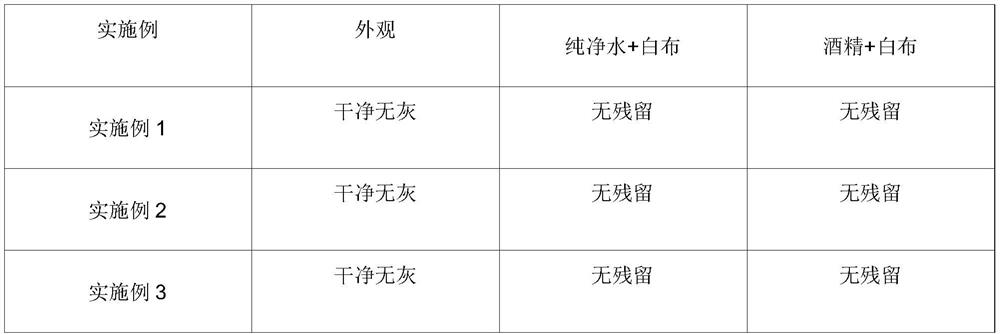A kind of ash remover after sealing of aluminum alloy anodic oxidation process and preparation method thereof
A kind of technology of anodic oxidation and deashing agent, applied in the direction of coating, surface reaction electrolytic coating, electrolytic coating, etc., can solve the problems of complex principle, labor-consuming, long operation time of sulfuric acid method, etc., and achieve simple manufacturing process and ash removal Effects with fast processing speed
- Summary
- Abstract
- Description
- Claims
- Application Information
AI Technical Summary
Problems solved by technology
Method used
Image
Examples
Embodiment 1
[0023] This embodiment discloses a kind of ash remover after the aluminum alloy anodic oxidation process is sealed, by weight, including:
[0024] h 2 SO 4 (98%): 30 copies;
[0025] Ammonium ferrate: 2 parts;
[0026] Ferric chloride: 5 parts;
[0027] Hydrogen peroxide: 10 parts;
[0028] Citric acid: 10 parts;
[0029] Pure water: 943 parts.
[0030] During production, add 2 / 3 of pure water to the reactor, and then add 30 parts of H 2 S0 4 (98%) automatically stirred for 10 minutes, then added 2 parts of ammonium ferrate, 5 parts of ferric chloride, 10 parts of citric acid, automatically stirred for 20 minutes, then added 10 parts of hydrogen peroxide, and finally added water to make the total volume 1000 Mix the parts to make the required ash remover.
Embodiment 2
[0032] This embodiment discloses a kind of ash remover after the aluminum alloy anodic oxidation process is sealed, by weight, including:
[0033] h 2 SO 4 (98%): 50 copies;
[0034] Potassium ferrate: 5 parts;
[0035] Ferric chloride: 5 parts;
[0036] Hydrogen peroxide: 15 parts;
[0037] Tartaric acid: 5 parts;
[0038] Pure water: 920 parts.
[0039] During production, add 2 / 3 of pure water to the reactor, and then add 50 parts of H 2 S0 4(98%) automatically stirred for 10 minutes, then added 5 parts of potassium ferrate, 5 parts of ferric chloride, 5 parts of tartaric acid, automatically stirred for 20 minutes, then added 15 parts of hydrogen peroxide, and finally added water to make the total volume 1000 parts Mix well to make the required ash remover.
Embodiment 3
[0041] This embodiment discloses a kind of ash remover after the aluminum alloy anodic oxidation process is sealed, by weight, including:
[0042] Ammonium ferrate: 20 parts;
[0043] Iron sulfate: 10 parts;
[0044] Hydrogen peroxide: 15 parts;
[0045] Citric acid: 20 parts;
[0046] Pure water: 925 parts.
[0047] During production, add 2 / 3 of pure water to the reactor, then add 10 parts of ammonium ferrate, 10 parts of ferric sulfate, 20 parts of citric acid, stir automatically for 20 minutes, then add 15 parts of hydrogen peroxide, and finally add water to set Make up to 1000 parts in total and mix well to make the desired ash remover.
PUM
| Property | Measurement | Unit |
|---|---|---|
| purity | aaaaa | aaaaa |
Abstract
Description
Claims
Application Information
 Login to View More
Login to View More - R&D
- Intellectual Property
- Life Sciences
- Materials
- Tech Scout
- Unparalleled Data Quality
- Higher Quality Content
- 60% Fewer Hallucinations
Browse by: Latest US Patents, China's latest patents, Technical Efficacy Thesaurus, Application Domain, Technology Topic, Popular Technical Reports.
© 2025 PatSnap. All rights reserved.Legal|Privacy policy|Modern Slavery Act Transparency Statement|Sitemap|About US| Contact US: help@patsnap.com


